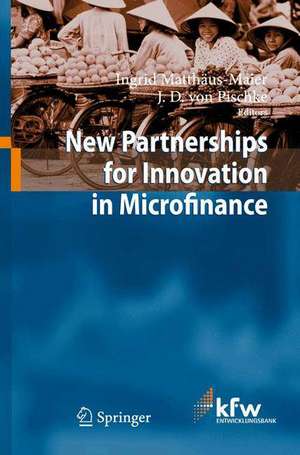New Partnerships for Innovation in Microfinance
Editat de Ingrid Matthäus-Maier, J. D. Pischkeen Limba Engleză Paperback – 23 mar 2009
| Toate formatele și edițiile | Preț | Express |
|---|---|---|
| Paperback (1) | 394.29 lei 6-8 săpt. | |
| Springer Berlin, Heidelberg – 23 mar 2009 | 394.29 lei 6-8 săpt. | |
| Hardback (1) | 405.28 lei 6-8 săpt. | |
| Springer Berlin, Heidelberg – 16 apr 2008 | 405.28 lei 6-8 săpt. |
Preț: 394.29 lei
Nou
Puncte Express: 591
Preț estimativ în valută:
75.46€ • 78.49$ • 62.29£
75.46€ • 78.49$ • 62.29£
Carte tipărită la comandă
Livrare economică 15-29 aprilie
Preluare comenzi: 021 569.72.76
Specificații
ISBN-13: 9783540938989
ISBN-10: 3540938982
Pagini: 404
Ilustrații: XV, 387 p.
Dimensiuni: 155 x 235 x 21 mm
Greutate: 0.56 kg
Ediția:2008
Editura: Springer Berlin, Heidelberg
Colecția Springer
Locul publicării:Berlin, Heidelberg, Germany
ISBN-10: 3540938982
Pagini: 404
Ilustrații: XV, 387 p.
Dimensiuni: 155 x 235 x 21 mm
Greutate: 0.56 kg
Ediția:2008
Editura: Springer Berlin, Heidelberg
Colecția Springer
Locul publicării:Berlin, Heidelberg, Germany
Public țintă
ResearchCuprins
Partnerships to Leverage Private Investment.- New Partnerships for Sustainability and Outreach.- Raising MFI Equity Through Microfinance Investment Funds.- Market Transparency: The Role of Specialised MFI Rating Agencies.- MFI Equity: An Investment Opportunity for the Broader Public?.- Microfinance and Economic Growth – Reflections on Indian Experience.- Microfinance Investments and IFRS: The Fair Value Challenge.- Partnerships to Leverage Private Investment.- Technology Partnerships to Scale up Outreach.- Remittance Money Transfers, Microfinance and Financial Integration: Of Credo, Cruxes, and Convictions.- Remittances and MFIs: Issues and Lessons from Latin America.- Using Technology to Build Inclusive Financial Systems.- Information Technology Innovations That Extend Rural Microfinance.- Banking the Unbanked: Issues in Designing Technology to Deliver Financial Services to the Poor.- Can Credit Scoring Help Attract Profit-Minded Investors to Microcredit?.- Credit Scoring: Why Scepticism Is Justified.- Partnerships to Mobilise Savings and Manage Risk.- Micropensions: Old Age Security for the Poor?.- Cash, Children or Kind? Developing Old Age Security for Low-Income People in Africa.- Microinsurance: Providing Profitable Risk Management Possibilities for the Low-Income Market.- Securitisation: A Funding Alternative for Microfinance Institutions.- Reducing Barriers to Microfinance Investments: The Role of Structured Finance.
Recenzii
From the reviews:
"The book presents valuable information with a strong analytical tilt. … targets economists and managers in banking and development finance organizations, as well as policy makers, international development organizations, and development agencies. Because it covers a range of issues related to funding microfinance, and is written in relatively simple language, yet intelligently argued, it can be used as a resource book for courses on microfinance funding and development. … a useful read for practitioners in the sector." (Meryem E. Faris, Microfinance Insights, Issue 7, July, 2008)
"The book presents valuable information with a strong analytical tilt. … targets economists and managers in banking and development finance organizations, as well as policy makers, international development organizations, and development agencies. Because it covers a range of issues related to funding microfinance, and is written in relatively simple language, yet intelligently argued, it can be used as a resource book for courses on microfinance funding and development. … a useful read for practitioners in the sector." (Meryem E. Faris, Microfinance Insights, Issue 7, July, 2008)
Textul de pe ultima copertă
Microfinance has experienced dynamic development. Today, microfinance providers reach close to 100 million clients worldwide and are growing fast. New partnerships expand the impact of microfinance even further. Three types of partnerships are examined in this book, each consisting of a thematic pillar. Pillar I focuses on equity investments in microfinance, especially the possibilities for engaging private investors through structured microfinance investment funds. Rating agencies are involved in providing more transparency in this emerging fund industry. Pillar II focuses on collaboration among microfinance providers, governments, private investors and technology companies which help microfinance institutions to integrate new technologies into their business models, reducing cost and increasing outreach to clients. Pillar III covers micropensions, microinsurance and the role of securitisation for the future of microfinance.
The blossoming of microfinance to embrace a wider constituency of providers and investors, and a broader range of instruments that can reach more clients has been a very positive confirmation of the United Nation’s designation of 2005 as the year of microcredit, or more inclusively, microfinance.
ELIZABETH LITTLEFIELD, Consultative Group to Assist the Poor (CGAP)
Microfinance is increasingly attractive to private investors. Pioneering deals initiated and supported by international financial institutions and bi-lateral development agencies, subject to the discipline of capital markets, have changed the structure of microfinance investment, opening new vistas for all participants.
PETER WOICKE, former Executive Vice President, The World Bank
Expanding outreach to the poor through finance is a process of continual innovation. Advances in internet technology and new forms of payment mechanisms hold great promise. Challenges on the ground include bridging the „lastmile" and upgrading the business processes or back offices of providers.
EDUARDO BAZOBERRY, Chief Executive Officer of PRODEM, Bolivia
The blossoming of microfinance to embrace a wider constituency of providers and investors, and a broader range of instruments that can reach more clients has been a very positive confirmation of the United Nation’s designation of 2005 as the year of microcredit, or more inclusively, microfinance.
ELIZABETH LITTLEFIELD, Consultative Group to Assist the Poor (CGAP)
Microfinance is increasingly attractive to private investors. Pioneering deals initiated and supported by international financial institutions and bi-lateral development agencies, subject to the discipline of capital markets, have changed the structure of microfinance investment, opening new vistas for all participants.
PETER WOICKE, former Executive Vice President, The World Bank
Expanding outreach to the poor through finance is a process of continual innovation. Advances in internet technology and new forms of payment mechanisms hold great promise. Challenges on the ground include bridging the „lastmile" and upgrading the business processes or back offices of providers.
EDUARDO BAZOBERRY, Chief Executive Officer of PRODEM, Bolivia
Caracteristici
Insight in the most innovative instruments and products currently used in the microfinance industry With articles written by leading practitioners, e.g. from microfinance service providers, investment funds, leading international financial institutions, communication technology companies, pension funds, microinsurance providers, who share their practical experience Includes supplementary material: sn.pub/extras










